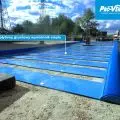A team of Wroclaw University of Technology students, consisting of: Mikołaj Kałużny, Maja Klawitter, Kornel Kurtys, Maria Opłatek and Bartłomiej Tuczapski had 24 hours to develop a conceptual design for a bridge that would connect two banks of the Tagus River in the Portuguese town of Algés. Their idea "SLOW DOWN AROUND" appealed to the judges of the "24H Architecture Competiton", who awarded it first place.
The challenge of the Ideasforward portal's 36th edition of the "24H Architecture Competiton" competition was to prepare in just 24 hours a conceptual design of a bridge with interesting architecture, using ecological solutions and referring to the traditions of Portugal. The organizers did not impose budget restrictions or specific design requirements on the participants. Thus, young architects were able to create a downright futuristic design.
Acharacteristic point is the huge glass sphere in the middle of the bridge
© Mikołaj Kałużny, Maja Klawitter, Kornel Kurtys, Maria Opłatek, Bartłomiej Tuczapski
First prize for PWr students
The submitted works were judged by a jury consisting of Portuguese architects Mário Chaves, Ana Lagoa, Pedro Lebre, Inês Estradas, Jorge Palma. From among the submissions, they selected the "SLOW DOWN AROUND" project by a team from Wroclaw University of Technology. The jury appreciated the interesting form of combining three elements of communication: transportation, a promenade and a spherical area as a resting place.
The conceptually rich bridge embodies a unique symbiosis between iconic and historical reference and the preservation of Portuguese natural heritage. The solution presented is visually strong. The dome placed on the bridge refers to futuristic scenarios for preserving the biosphere. It is tocThe interesting form of combining three elements: communication, promenade and dome," Ana Lagoa concluded.
The bridge is located on the Tagus River in the Portuguese town of Algés
© Mikołaj Kałużny, Maja Klawitter, Kornel Kurtys, Maria Opłatek, Bartłomiej Tuczapski
Ecology was also an important aspect for the jury.
As Inês Estradas emphasized:
Made from recycled materials, this project reduces the need for raw materials, saves energy and reduces gas emissions. All of these aspects are important not only for budgeting, but above all with future generations in mind.
Slow down around
The award-winning bridge crosses Portugal's Tagus River and connects the south bank to the north. Proposed by architecture students, the structure measures 6,500 meters in length. The design includes two main transportation paths, which the authors divided into subgroups of communication: vehicular, urban transportation, industrial transportation and a separate pedestrian and bicycle communication.
The bridge is made of recycled materials
© Mikołaj Kałużny, Maja Klawitter, Kornel Kurtys, Maria Opłatek, Bartłomiej Tuczapski
The bridge, which has a rather simple, repetitive form, allows for a quick crossing thanks to a straight line connecting the two banks. A distinctive point is the huge glass sphere in the middle of the establishment. It forces drivers to slow down and contemplate the surrounding nature. The interior of the dome would be filled with plants that have been classified as extinct species in Portugal. For pedestrians and cyclists, it would be a place for a short rest, relaxing among the greenery and an opportunity to look at flora threatened with extinction.
Because of the idea of reducing vehicular traffic, we created a "sphere of life" that is accessible by non-carbon-emitting transportation. The main idea that pushed us to create the "sphere of life" was to put pedestrian transportation at the top of the hierarchy, as well as to support the extinct species of Portuguese vegetation, the authors explain.
The interior of the dome is filled with endangered plants
© Mikołaj Kałużny, Maja Klawitter, Kornel Kurtys, Maria Opłatek, Bartłomiej Tuczapski
recycling and sustainable architecture
The award-winning bridges project is an example of sustainable architecture. The young architects envisioned the use of recycled materials and the installation of solar and wind energy harvesting systems, including photovoltaic panels and small windmills that harness wind energy, and walkways that generate electricity from kinetic energy generated by the steps of passersby. The bridge would be built of steel, but the project's authors also proposed using wooden elements for the pedestrian path.





























